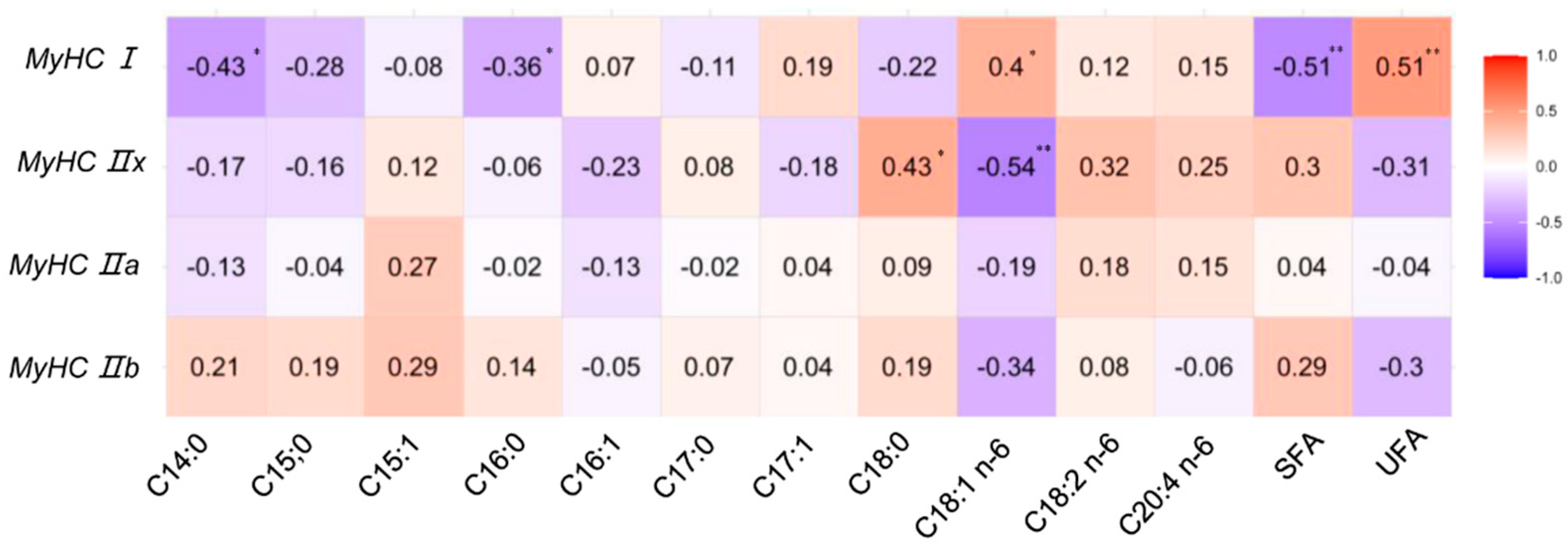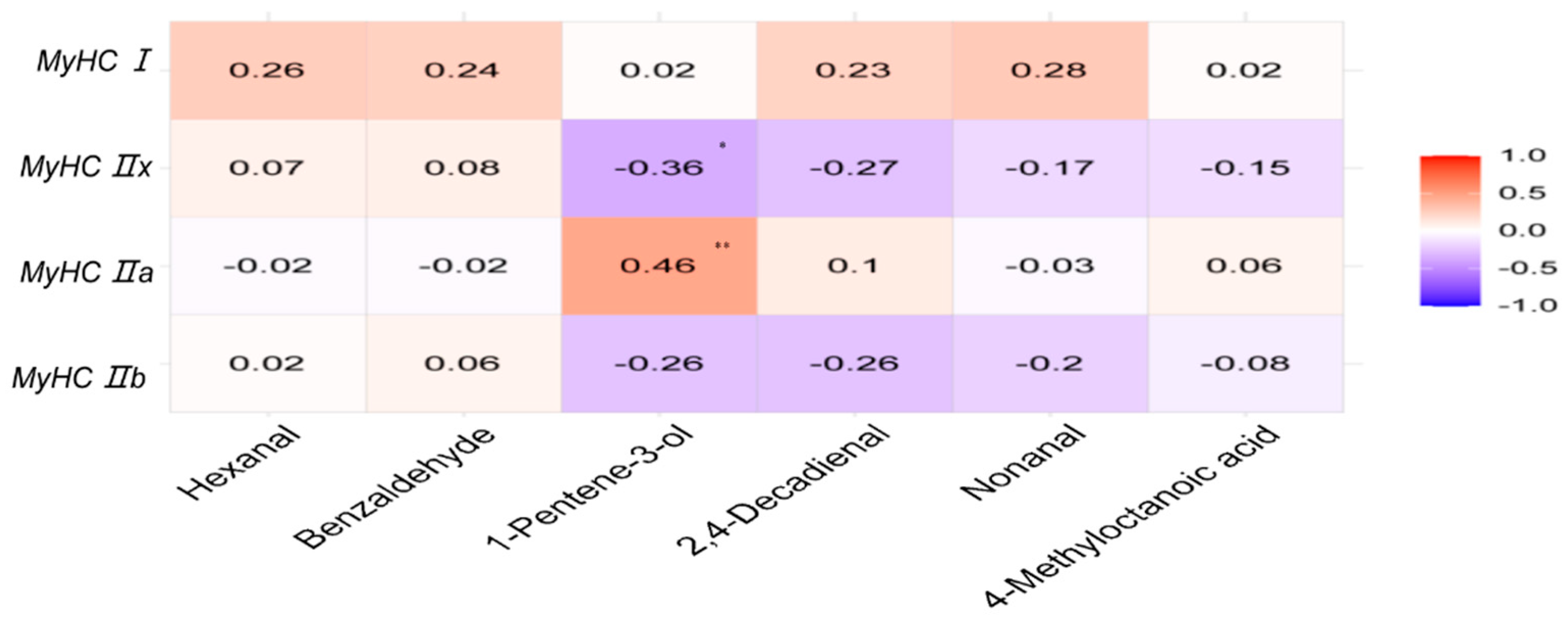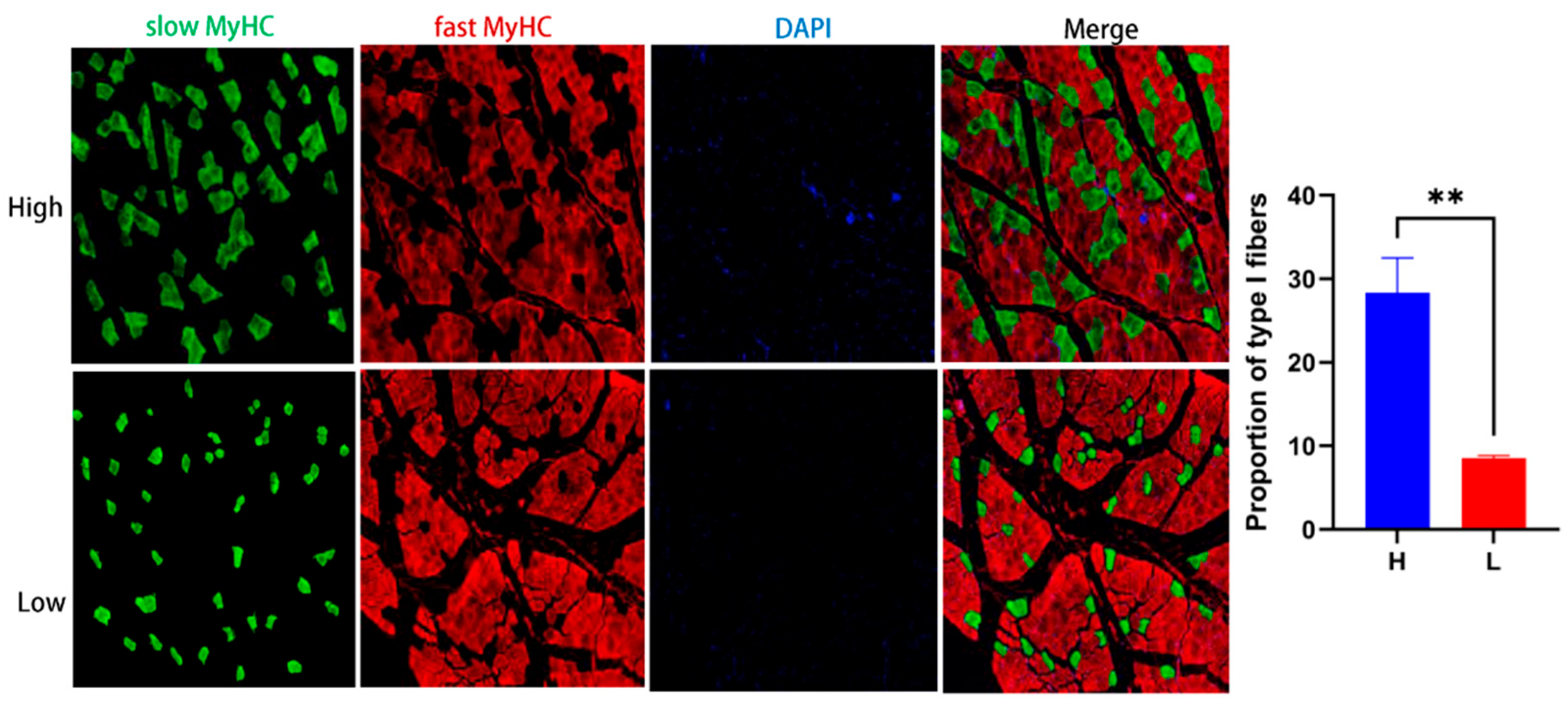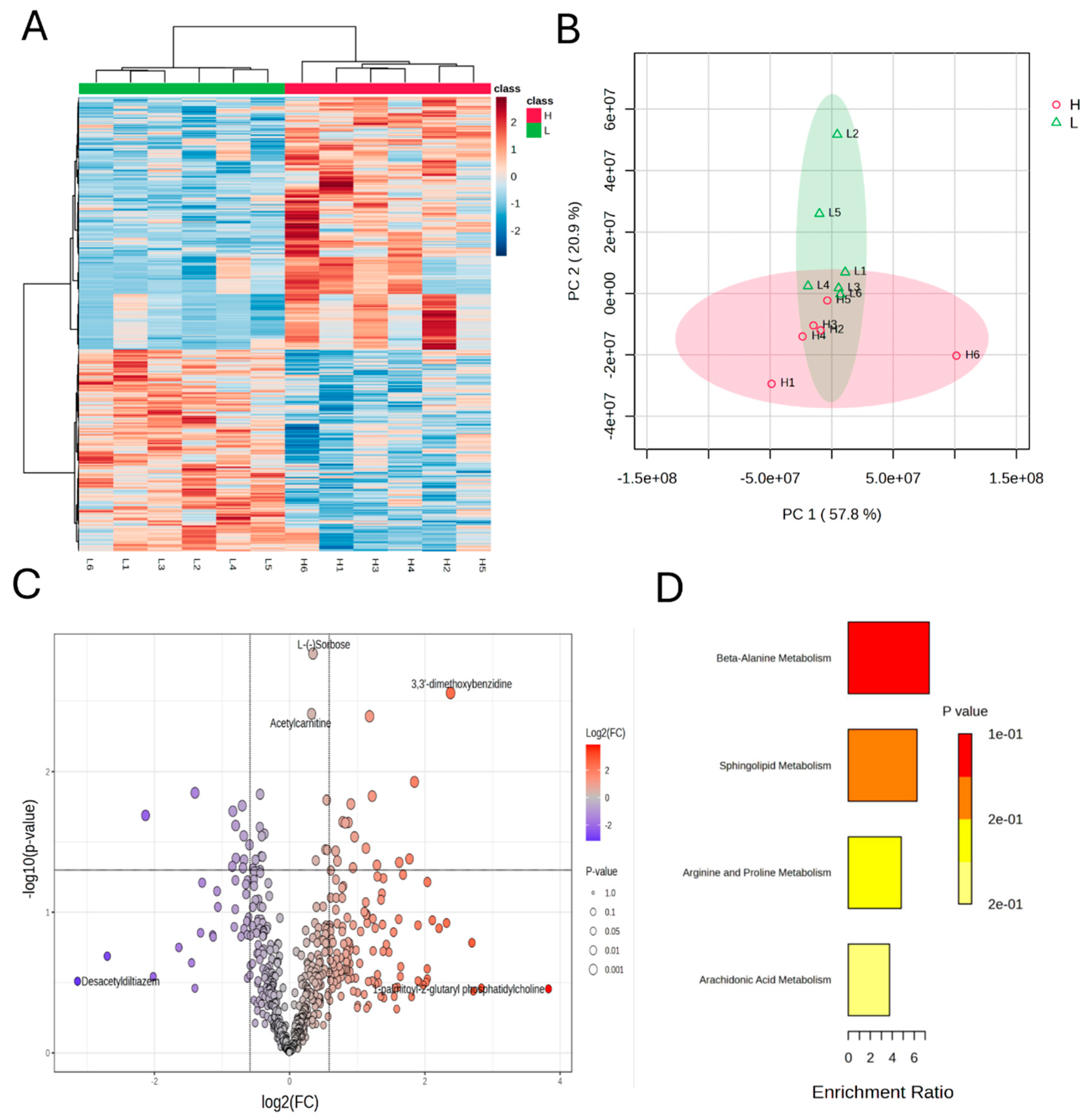1. Introduction
Lamb meat is highly valued in global markets not only for its palatability but also for its rich nutritional profile. As a source of high-quality protein, lamb supplies all essential amino acids required for human growth and development. It is also a key dietary source of micronutrients such as iron (especially heme iron, which is highly bioavailable), zinc, selenium, and B vitamins including B12 and niacin [
1,
2]. Moreover, lamb contains a favorable balance of saturated and unsaturated fatty acids, including conjugated linoleic acid (CLA) and omega-3 polyunsaturated fats, which have been linked to cardiovascular and metabolic health benefits [
3]. As such, improving lamb meat quality is not only vital for meeting consumer sensory expectations but also holds broader implications for human nutrition and public health [
4].
Meat quality is a multifactorial trait shaped by genetic, physiological, and biochemical characteristics of skeletal muscle. Among these, the composition of muscle fiber types has emerged as a key determinant, influencing not only the appearance and texture of meat but also its nutritional value and flavor profile [
5,
6]. In livestock species such as cattle, pigs, and sheep, skeletal muscle is composed of diverse fiber types classified according to their contractile speed and metabolic specialization. These include slow-twitch oxidative fibers (type I) and fast-twitch fibers, which can be further subdivided into oxidative (type IIa), intermediate (type IIx), and glycolytic (type IIb) types [
7]. The expression of specific myosin heavy chain (MyHC) isoforms serves as a molecular marker for each fiber type and reflects the muscle’s adaptation to different functional demands [
8].
Meat quality assessment encompasses a suite of physical, chemical, and sensory parameters. These include tenderness, juiciness, flavor, and color, along with quantitative traits such as pH, water-holding capacity, cooking loss, and shear force. From a compositional standpoint, quality is shaped by intramuscular fat (IMF) content and the profiles of amino acids, fatty acids, and low-molecular-weight metabolites such as nucleotides and sugars [
9,
10]. These compounds directly affect taste and aroma and are, in turn, modulated by muscle fiber composition [
11].
In ruminants, the
longissimus lumborum (
LL) muscle is widely used as a benchmark for meat quality due to its commercial significance and sensitivity to muscle fiber type. Muscles enriched in oxidative fibers (MyHC I) tend to display superior water-holding capacity, deeper red color, slower pH decline postmortem, and improved tenderness—traits linked to their aerobic metabolism and high mitochondrial density [
12]. In contrast, glycolytic fiber-rich muscles (MyHC IIb) are more susceptible to rapid pH decline, increased drip and cooking losses, and inferior tenderness, due to their anaerobic metabolism and limited oxidative capacity [
13].
The biochemical underpinnings of these differences lie in the enzymatic and metabolic properties of the fiber types. Oxidative fibers (types I and IIa) are characterized by the elevated activity of mitochondrial enzymes such as succinate dehydrogenase (SDH) and citrate synthase (CS), enabling sustained aerobic respiration via β-oxidation and the tricarboxylic acid (TCA) cycle [
14,
15]. These fibers are rich in myoglobin and mitochondria, contributing to their dark color and metabolic resilience. Glycolytic fibers (type IIb), by contrast, rely on anaerobic glycolysis, with a high activity of enzymes such as lactate dehydrogenase (LDH) and phosphofructokinase (PFK), leading to rapid ATP generation but also to lactate accumulation and faster postmortem acidification [
16]. These enzymatic distinctions not only shape muscle energetics but also critically affect the biochemical pathways that govern meat color, pH, and tenderness during and after slaughter [
17].
Beyond physical traits, muscle fiber types also influence the biochemical flavor landscape of meat. Key sensory properties such as taste and aroma arise from the interplay between taste-active compounds (e.g., free amino acids, peptides, nucleotides) and volatile aroma compounds formed during cooking. Notably, branched-chain fatty acid derivatives such as 4-methyloctanoic acid and 4-methylnonanoic acid contribute to the distinct “mutton flavor” often perceived negatively by consumers in certain markets [
18,
19]. The abundance of such compounds is influenced by both fiber metabolism and lipid composition [
20].
Although the role of muscle fiber composition in shaping meat quality is well established in pigs and cattle, integrated studies in lamb that link MyHC isoform expression with biochemical and sensory quality traits remain scarce. In particular, relationships between fiber type distribution and volatile compounds, fatty acid and amino acid profiles, and global metabolomic changes are poorly characterized.
In this study, we sought to systematically characterize the associations between MyHC isoform expression and key meat quality attributes in lamb longissimus lumborum muscle. Using a multi-omics approach—including qRT-PCR, chemical composition analysis, gas chromatography–mass spectrometry (GC–MS), and untargeted metabolomics—we investigated how fiber type composition influences traditional meat quality metrics, nutritional composition, and flavor-related metabolites. Our findings provide new insights into the molecular basis of lamb meat quality and offer a foundation for improving eating quality through genetic selection, nutritional modulation, or production management.
2. Materials and Methods
2.1. Animals and Sample Collection
A total of 30 healthy 6-month-old intact male lambs (F1 crossbred of Suffolk rams and Small-tailed Han ewes) were selected from a commercial farm. All animals were housed indoors under consistent management conditions, with ad libitum access to feed and water. The diet was formulated to meet the nutritional requirements for growing lambs, and the detailed feed composition and nutrient content are provided in
Table 1. Prior to slaughter, all animals were fasted for 24 h with free access to water. Slaughter was conducted in accordance with institutional animal care and ethical guidelines. Within 30 min postmortem, the
longissimus lumborum (
LL) muscle was collected, immediately snap-frozen in liquid nitrogen, and stored at −80 °C for subsequent molecular and biochemical analyses.
2.2. Analysis of Muscle Fiber Type Marker Gene Expression
Total RNA was extracted from longissimus lumborum (LL) muscle samples using TRIzol reagent (R0016, Beyotime, Shanghai, China), following the manufacturer’s protocol. RNA concentration and purity were assessed using a NanoDrop spectrophotometer (Thermo Fisher Scientific, Waltham, MA, USA). First-strand cDNA was synthesized from 1 μg of total RNA using a BeyoRT™II First Strand cDNA Synthesis Kit (D7168M, Beyotime).
Quantitative real-time PCR (qPCR) was conducted using SYBR Green Master Mix (D7260, Beyotime, Shanghai, China)) on a Real-Time PCR System (CFX96 opus, Bio-Rad, Hercules, CA, USA). Expression levels of four muscle fiber subtype maker genes—MyHC I, IIa, IIx, and IIb—were quantified, with β-actin serving as the internal control. Relative expression levels were calculated using the 2
−ΔΔCt method. Each sample was analyzed in triplicate technical replicates to ensure accuracy and reproducibility. Primer sequences used in the analysis are provided in
Table 2.
2.3. Measurement of Meat Quality Traits
Meat quality traits and muscle composition were evaluated using thirty
longissimus lumborum (
LL) samples. The ultimate pH (pH
24) of the
longissimus lumborum muscle was determined 24 h postmortem using a calibrated pH meter (S220, Mettler Toledo, Columbus, OH, USA) equipped with a spear-tip probe, which was directly inserted into the muscle sample. For each sample, pH was measured at three different points, and the average value was used for analysis. Meat color was assessed after 20 min of blooming at room temperature to allow oxygenation of myoglobin. A colorimeter (CR-400, Konica Minolta, Tokyo, Japan) was used to record lightness (L*), redness (a*), and yellowness (b*) according to the CIE system. Measurements were taken with an 8 mm aperture, 10° standard observer, and D65 illuminant. The device was operated in tristimulus mode, and spectral reflectance data were not recorded. Cooking loss was determined by weighing 40 g meat samples before and after thermal treatment in a water bath at 75 °C until the internal temperature reached 70 °C. Meat tenderness was measured using a texture analyzer (TA.XTplus, Stable Micro Systems, Godalming, UK) equipped with a Warner–Bratzler shear force (WBSF) blade. Each cooked meat sample was cut into 1.0 cm × 1.0 cm × 3.0 cm strips parallel to the muscle fiber direction. Shear force measurements were performed perpendicularly to the fiber direction at a crosshead speed of 200 mm/min. The peak force required to shear through the sample was recorded, and the average of three replicates was used as the final value. Muscle moisture, crude protein, and intramuscular fat contents were determined using standard methods: direct drying (GB 5009.3-2016) [
21], Kjeldahl nitrogen determination (GB 5009.5-2016) [
22], and Soxhlet ether extraction (GB 5009.6-2016) [
23], respectively.
2.4. Fatty Acid Profile Analysis
Lipid extraction from muscle samples was performed using the Folch method, followed by methylation to form fatty acid methyl esters (FAMEs). FAMEs were then analyzed by gas chromatography (GC) equipped with a flame ionization detector. Individual fatty acids were identified and quantified by comparing retention times with those of known standards. The analysis was conducted in accordance with the Chinese National Food Safety Standard GB 5009.168-2016 [
24].
2.5. Free Amino Acid Analysis
Free amino acids were extracted from homogenized and deproteinized muscle samples and quantified using a high-speed amino acid analyzer. The concentrations of total and individual amino acids, including essential amino acids, were measured and compared among samples. The procedure was performed following the Chinese National Food Safety Standard GB 5009.124-2016 [
25].
2.6. Volatile Flavor Compound Analysis
Approximately 5 g of longissimus lumborum muscle tissue was pretreated and subjected to analysis of volatile flavor compounds using gas chromatography–mass spectrometry (GC-MS). Seven volatile compounds associated with the characteristic odor of lamb (including 4-methyloctanoic acid, 4-methylnonanoic acid, hexanal, benzaldehyde, pentanol, decadienal, and nonanal) were identified. Volatile compounds were extracted using solid-phase microextraction (SPME), and identification was performed by comparing retention times and mass spectra with those in commercial libraries (e.g., NIST).
2.7. Immunofluorescence Staining of Muscle Fiber Types
Muscle fiber type composition was determined using immunofluorescence staining. Serial cryosections (10 µm thick) of the LL muscle were fixed, blocked, and incubated with monoclonal antibodies specific for slow-twitch (MyHC I, ab234431, Abcam, Cambridge, UK) and fast-twitch (MyHC II, ab91506, Abcam, Cambridge, UK) fibers. Secondary antibodies conjugated with fluorophores were applied, and images were captured using a fluorescence microscope (IX73, Olympus, Tokyo, Japan). The relative proportion of slow- and fast-twitch fibers was quantified using ImageJ software (v1.54g). Based on the proportion of slow-twitch fibers, six samples with the highest and six with the lowest MyHC I content were selected for metabolomic analysis.
2.8. Untargeted Metabolomics
Untargeted metabolomic profiling of
longissimus lumborum muscle was performed using UHPLC-QTOF-MS. Briefly, frozen samples were thawed at 4 °C, homogenized, and extracted with methanol/acetonitrile/water (2:2:1,
v/
v). After vortexing, sonication, and centrifugation, the supernatant was dried and reconstituted in acetonitrile/water (1:1,
v/
v) for analysis. Chromatographic separation was conducted on an Agilent 1290 UHPLC system (Agilent Technologies, Santa Clara, CA, USA) using a HILIC column, and metabolites were analyzed on a Triple TOF 6600 mass spectrometer (AB SCIEX, Framingham, MA, USA), in both positive and negative ion modes. The MS was operated in data-dependent acquisition mode with dynamic exclusion. Raw data were converted to mzXML format and processed using XCMS for peak detection and alignment. Metabolite annotation was performed by matching MS/MS spectra against public databases (HMDB, KEGG, METLIN) and an in-house spectral library based on accurate mass and fragmentation patterns. Principal component analysis (PCA), heatmap clustering, volcano plots, and pathway enrichment were performed using MetaboAnalyst 5.0 [
26]. Metabolites with VIP > 1,
p < 0.05, and |log2FC| > 1 were considered significantly different. Pathway enrichment was performed based on KEGG database annotations.
2.9. Statistical Analysis
Correlation analyses between MyHC isoform expression and meat quality traits, fatty acid profiles, amino acids, and volatile compounds were performed using Pearson’s correlation coefficients in SPSS 27.0 software. Differences between high and low slow-twitch groups were analyzed using unpaired t-tests. Statistical significance was set at p < 0.05, and highly significant differences at p < 0.01. Graphs were generated using GraphPad Prism 9.5.
4. Discussion
Skeletal muscle fiber type is a fundamental determinant of meat quality, influencing both technological traits and sensory attributes. Although previous studies highlighted the general importance of fiber type composition in shaping meat quality in species such as pigs and cattle [
5,
27], they have not systematically examined the specific roles of individual MyHC isoforms in lamb, particularly with respect to volatile flavor compounds and metabolic pathways.
Our study bridges this gap by comprehensively analyzing the expression of four major MyHC isoforms (I, IIa, IIx, and IIb) in lamb longissimus lumborum muscle and linking them to a broad range of meat quality traits, including color parameters, shear force, cooking loss, amino acid composition, fatty acid profiles, volatile flavor compounds, and untargeted metabolomic features. This multi-dimensional analysis allowed us to dissect the metabolic and sensory consequences of each fiber type with unprecedented resolution in lamb, a species for which detailed fiber–flavor relationships have been poorly characterized.
We found that MyHC I (oxidative slow-twitch fibers) was positively associated with favorable meat traits, such as increased redness (a*), water-holding capacity, unsaturated fatty acids (e.g., oleic acid), and essential amino acids. These results are consistent with previous findings in pigs and yaks, where oxidative fibers are linked to improved color stability and nutritional value [
12,
28]. The increased redness in MyHC I-rich muscles likely results from an elevated myoglobin content and reduced glycolytic activity, which mitigates pH decline postmortem and preserves meat color [
29].
The observed enrichment of unsaturated fatty acids (UFAs) in oxidative fibers can be attributed to their distinct metabolic properties. Oxidative fibers, characterized by MyHC I expression, possess greater mitochondrial density, a higher capillary supply, and elevated enzymatic activities associated with fatty acid transport and β-oxidation [
30]. These features facilitate the preferential uptake and catabolism of UFAs, especially oleic acid, for sustained aerobic energy production. This physiological preference helps explain why MyHC I-rich muscles accumulate more UFAs, contributing to their nutritional advantages and flavor precursor potential [
31,
32].
Furthermore, the positive association between MyHC I and essential amino acids such as lysine, valine, and glutamic acid suggests enhanced nutritional quality and flavor precursors, which is in line with observations in pigs, where oxidative muscles contain more taste-active amino acids and dipeptides [
33]. Conversely, MyHC IIb fibers, representative of fast-glycolytic fibers, showed negative associations with amino acid content and were linked to higher shear force and greater cooking loss, indicating tougher and less juicy meat. This supports previous findings that glycolytic fibers are prone to excessive postmortem lactate accumulation, leading to adverse effects on proteolysis and tenderness [
18,
34].
Volatile compound profiling further revealed that muscle fiber types significantly modulate lamb flavor. Despite not reaching statistical significance, MyHC I expression showed a strong positive correlation with nonanal, a pleasant aldehyde generated from oleic acid oxidation, known to impart fatty and citrus-like aromas [
35]. The enrichment of oleic acid in oxidative fibers provides a plausible precursor source for nonanal, highlighting the contribution of fiber metabolism to flavor generation. In contrast, MyHC IIb and IIx were strongly associated with 4-methyloctanoic acid and 4-methylnonanoic acid, branched-chain fatty acids that are key contributors to the species-specific “mutton” odor often rejected by consumers [
36]. These volatiles are thought to derive from branched-chain amino acid catabolism and are more prevalent in glycolytic muscle regions, as previously reported in sheep and goats [
37].
In addition, our study provides novel evidence that MyHC IIx expression exhibited a significant negative correlation with 1-penten-3-ol (
p < 0.05), a compound linked to grassy and green off-flavor notes, suggesting that higher IIx expression may reduce the accumulation of unfavorable aroma volatiles. MyHC IIa, often considered an intermediate fiber type, demonstrated a significant positive correlation with 1-penten-3-ol (
p < 0.01), indicating a differential effect between intermediate fiber types. These findings highlight the potential role of muscle fiber type composition in shaping the flavor profile of lamb through the modulation of volatile metabolite production and underscore the influence of intermediate fibers on flavor quality—an area that warrants further investigation [
38].
Untargeted metabolomics further supported the metabolic divergence among fiber types. Muscles with high MyHC I expression exhibited increased levels of C17-sphinganine and isobutyryl-L-carnitine, indicative of enhanced mitochondrial lipid β-oxidation [
39]. The upregulation of carnitine-related metabolites aligns with the aerobic metabolic nature of oxidative fibers. Moreover, these muscles also showed elevated levels of γ-glutamyl peptides and plant-derived antioxidants (e.g., evodiamine, juglone), suggesting improved flavor complexity, kokumi taste potential, and oxidative stability. The γ-glutamyl peptides were associated with mouthfulness and prolonged flavor perception in meat [
40], while the antioxidant compounds may support lipid stability and shelf life [
41]. Their selective enrichment in oxidative fibers may reflect differences in uptake or metabolic utilization.
In contrast, the lower levels of phosphocreatine and glycolytic dipeptides (e.g., Met-Phe, Thr-His) in oxidative muscles are consistent with their reduced reliance on anaerobic energy systems. These metabolites in fast-twitch glycolytic fibers favor the utilization of rapid ATP generation through glycolysis and phosphagen pathways [
42]. This divergence in energy metabolism provides a molecular basis for the observed meat quality differences between oxidative and glycolytic fiber types.
Overall, our findings substantially expand upon prior research by providing an integrative view of how MyHC isoform composition influences not only structural and nutritional traits but also flavor compound profiles and underlying metabolic mechanisms in lamb. Unlike earlier studies that typically classified muscle fibers into broad oxidative or glycolytic categories, our work offers a detailed characterization of all four major MyHC isoforms (I, IIa, IIx, IIb), allowing for more precise associations with specific meat quality parameters. By simultaneously evaluating a wide range of meat quality traits—including volatile flavor compounds, metabolomic markers, and conventional technological indices—our study establishes comprehensive links between fiber type composition and both sensory and nutritional attributes. Furthermore, by focusing specifically on lamb meat, our research fills a critical gap in the literature, as high-resolution data on muscle fiber–flavor interactions in this species have been limited. This species-specific insight represents a valuable contribution to the understanding of lamb meat quality and consumer acceptability.
These findings provide important implications for meat production and quality control. Increasing the proportion of oxidative fibers (especially MyHC I) through dietary strategies, exercise, or selective breeding may improve consumer acceptance of lamb meat by enhancing its tenderness, nutritional value, and flavor profile while reducing the intensity of undesirable mutton odor. Given the unique challenges of lamb flavor perception in certain markets, our study suggests that muscle fiber modulation could serve as a viable strategy to develop lamb products with more favorable sensory properties.
In conclusion, this study provides a comprehensive framework linking MyHC isoform expression to lamb meat quality, combining molecular, metabolic, and sensory data to reveal how muscle fiber phenotype shapes flavor, tenderness, and nutritional composition. Future research incorporating single-cell transcriptomics, fiber-specific proteomics, and targeted flavoromics will further elucidate the regulatory networks underlying muscle fiber–meat quality interactions and help design optimized production strategies for high-quality lamb meat.













